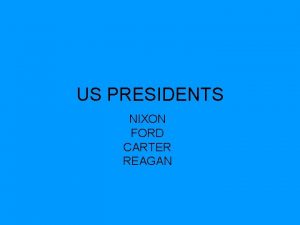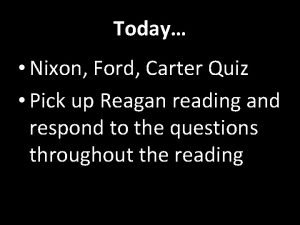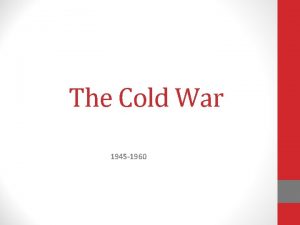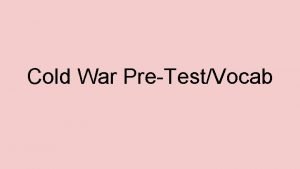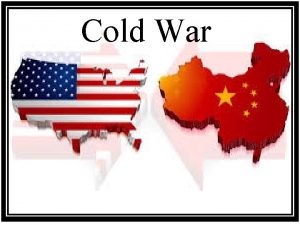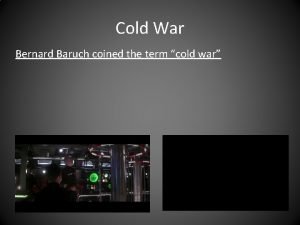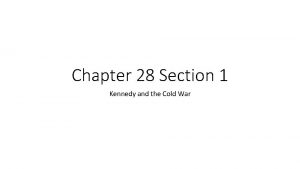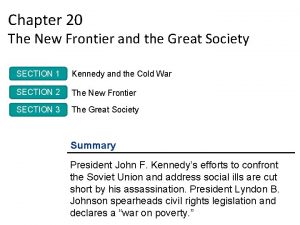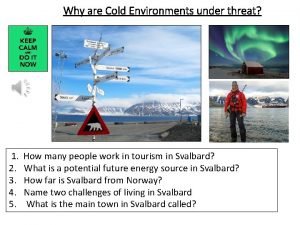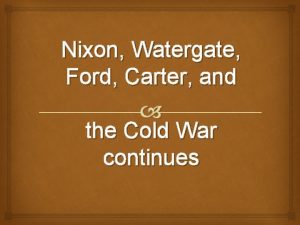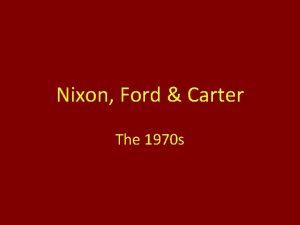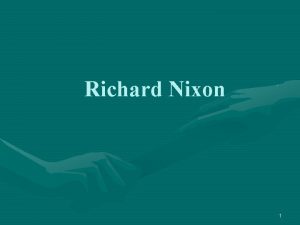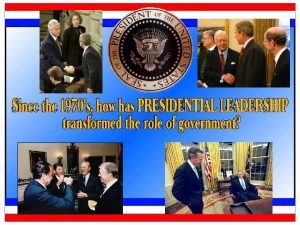The Cold War Under Nixon Ford and Carter











- Slides: 11

The Cold War Under Nixon, Ford, and Carter 1969 -1980

Nixon’s Vietnam Policy § Paris peace talks began in May 1968, but didn’t reach an agreement until January 1973. § Nixon began the policy of Vietnamization, replacing U. S. troops with South Vietnamese soldiers. § Nixon appealed to “the silent majority” who quietly supported his policies. § Kent State University (May 4, 1970) – Student protest against Nixon’s war policies turned violent. § When the Pentagon Papers were leaked to the American public in 1971, they revealed several facts of the war that had been previously kept secret – including the expansion of bombing raids in Laos and Cambodia.

Aftermath of the War § After American forces withdrew (1973), South Vietnam surrendered & Vietnam became unified under the Communists in 1975. § Approximately 3, 000 of American soldiers were listed as POWs or MIAs (or “body not recovered”) & some remain unaccounted for.

Henry Kissinger § Kissinger applied a realpolitik approach to his foreign policy actions. § Nixon & Kissinger’s greatest accomplishment was in bringing about détente, a relaxation in tensions between the U. S. & Communist China & USSR.

A New Approach to China § Kissinger saw that the relationship between China and the USSR was deteriorating. § In October 1971, Nixon’s administration recognized Communist China. § In February 1972, Nixon became the first American President to visit China.

Limiting Nuclear Arms § The U. S. & the Soviet Union signed the first Strategic Arms Limitation Treaty, known as SALT I in 1972. § While this agreement didn’t get rid of the stockpile of nuclear weapons that had built up, it did attempt to establish a balance between the two nations and proved that arms negotiations were possible.

Foreign Policy–Southeast Asia § Ford asked for military aid to help South Vietnam in spring 1975. § Congress was prepared to invoke the War Powers Act to keep the President from taking action without a formal declaration of war from Congress.

Foreign Policy - Asia, Europe, and Africa § Asia —Continued friendship with China & was the 1 st President to visit Japan. § Europe — Signed the Helsinki Accords (1975), agreements on European security which settled border disputes and continued the easing of Cold War tensions. § Soviet Union – Continued Strategic Arms Limitation Talks (SALT) with the Soviet Union. § Africa — Developed relationships with newly independent African countries.

Carter’s Foreign Policy § Carter’s 1978 meeting with Egyptian & Israeli leaders resulted in the Camp David Accords, which created a framework for peace in the Middle East and improved U. S. relations with both nations. § Soviets were angered by Carter’s support of Soviet dissidents, those who criticized their government. § Carter signed the SALT II treaty. Though it was never ratified, but both nations followed its terms. § Carter also pardoned those who had fled to Canada to avoid the draft.

Soviet Invasion of Afghanistan § The Soviet Union invaded Afghanistan in 1979. § To show American disapproval, Carter boycotted the 1980 summer Olympic Games in Moscow.

The Iran Hostage Crisis § In January 1979, a revolution in Iran replaced the pro-American shah with Ayatollah Khomeini, an anti-Western leader. § When Carter allowed the displaced shah to enter the U. S. to seek medical treatment, angry Khomeini followers seized the American embassy in Tehran. § Fifty-two Americans were taken hostage for 444 days. Carter’s inability to resolve the hostage crisis would be a major deciding factor in the 1980 election. § Although the hostage crisis is not directly related to the Cold War, Iran opens negotiations with the U. S. for the hostages’ release partially as a response to fear of Soviet aggression following the invasion of their neighbor, Afghanistan.
 Nixon ford carter reagan
Nixon ford carter reagan Lesson 1 the origins of the cold war
Lesson 1 the origins of the cold war 882
882 Proxy wars during the cold war
Proxy wars during the cold war Tricky dick
Tricky dick Korean war causes and effects
Korean war causes and effects Pretest communism and the cold war
Pretest communism and the cold war Communist and capitalist countries cold war
Communist and capitalist countries cold war Domino theory
Domino theory Chapter 28 section 1 kennedy and the cold war
Chapter 28 section 1 kennedy and the cold war Chapter 20 section 1 kennedy and the cold war
Chapter 20 section 1 kennedy and the cold war Economic activity
Economic activity
